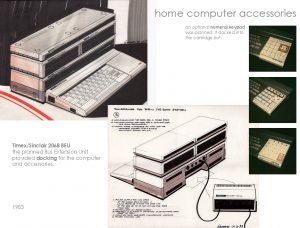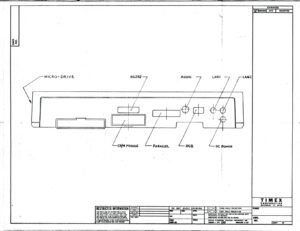
The TS2060 Interface Unit provides the electronics, connectors, and firmware to adapt the TS2068 Computer to control:
- Up to 8 TS2065 Microdrive transports
- CP/M Module – a RAM/ROM plug-in to extend the unit to support the CP/M operating system on the TS2068.
- A printer – Centronics parallel interface.
- RS-232-C interface – for attachment of compatible non – Timex peripherals. ( 9 wire )
- Local Area Network – for interconnection of up to 64 TS2068 computers via the Sinclair 2 wire circuit.
- System Buss Expansion – a 64 pin connector on the rear of the unit with the system buss buffered to drive up to six additional loads.
Outputs will also included:
- RGB Monitor – TTL level drive with composit and vertical sync.
- Audio – buffered low level output for external amplifier.
Initially, the design of the interface unit was executed in LS-TTL to speed first production deliveries. A parallel effort was planned to provide a cost reduced version in gate array technology. The cabinetry and many of the circuits were designed to allow inclusion of a controller for floppy disc drives. It was not known if both microdrives and floppy discs could be incorporated together or if one must replace the other.
Mass Storage/ Controller
The Microdrive Mass Storage subsystem consisted of 1 to 8 Microdrive transports and the control circuitry and firmware included in the Interface Unit. Microdrive Transports were connected daisy-chain fashion to the control unit, receiving control, data, and power over a single flat cable.
Each Microdrive Transport accommodated a removable endless loop tape cartridge capable of storing at least 85k bytes of program, data, or memory images organized as files. The tape cartridge holds 200 inches of magnetic tape that moves at 30 inches per second when necessary to perform read/ write/ search functions. Data is recorded on the tape in two tracks in an FM format at approximately 3333 bpi achieving a data rate of approximately 12.5k bytes per second. Sectoring is completely soft with a sector length of 512 formatted data bytes.
The controller unit includes circuitry to select an individual Microdrive transport, and to interface data and control signals between the TS2068 computer and the selected transport. Data separation, track selection, serialization/deserialization, read/write control, and erase control functions are performed by the controller. Firmware in the form of a 16k byte ROM is included to permit control of the Microdrive(s) from the TS2068 keyboard using the appropriate ’keywords’ already imprinted. Extensions to the Timex/ Sinclair are provided in the firmware to support a channel/ data stream mechanism. An automatic mechanism is implemented for selection/ deselection of the ROM.
An optional module can be plugged into the interface unit to extend the operation of the system to acommodate the CP/M Operating system. The CP/M module consists of a plug in card with 32k bytes of dynamic RAM and a 1K byte ROM installed. Incorporated into the ROM is the ’cold boot’ loader program necessary for system startup in the CP/M mode. The RAM is switched into the system under software (I/O port) control to enable a 64k byte contiguous RAM space Starting from address Oh. This architecture is necessary to support the CP/M operating system. A switch and logic is provided in the interface unit to allow this mode of Operation upon power-up. The operating system program is loaded from microdrive tape and runs out of RAM. Thereafter the operating system functions usually performed by disk drives are performed on the microdrive tape.
Printer Interface
The printer interface is an industry standard Centronics Parallel type. Support is provided in the firmware for the Timex TS2080 dot matrix impact printer or other Centronics compatible printers. A 34 conductor connector is provided.
Access to the interface port is supported by either of two channels; The ’C’ channel for listings or character oriented data and the ’G’ channel for graphics data. The ’G’ channel sends the full 8 bit data allowing control codes to be sent directly to the attached printer. The ’C’ channel will not send control codes.
RS-232-C Interface
An abbreviated 9 wire (common industry practice) RS-232-C interface that operates at baud rates from 50 to 19,200 is provided. The standard DB-25 connector is located at the rear of the unit. The mode of operation is half-duplex wth One start bit, one stop bit, and without parity. Attachment of serial printers, modems and other compatible devices is therefore allowed.
Access to the RS-232-C port is supported by either of two channels; The ’T’ channel is normally used for listings and ether ASCII character oriented data. The ’B’ channel is used to send full 8 bit codes for memory images or control codes.
Local Area Network
The local area network allows linking up to 64 Interface Unit equipped TS2068 computers in a daisy chain fashion with up to 100 meters of interconnect cables total. A network capable transferring programs, data, and messages at 937k baud is thereby formed. Transmission between individual computers is supported along with a broadcast mode .
Access to the network is supported in the firmware via the ‘N’ channel.
RGB Output
The R G B output provides positive TTL level signals to drive a compatible monitor. Red, Green, Blue, and sync signals are developed. Higher resolution (horizontal) than can be displayed on a television set is achieved. A 9 pin ‘D’ female style connector is used and a cable (not supplied) will be required to connect the monitor to the interface unit.
Audio Output
The audio output connector, a standard RCA phono jack
Provides a low level buffered signal to allow connection of an external amplifier and speaker for increased sound level. The internal speaker in the associated TS2068 is not muted.
System Buss Expansion
The TS2068 expansion buss is buffered and brought out to a connector on the back of the Interface Unit. The connector is the same as and is in the same position as the expansion connector on the TS2068 console. Peripherals may be attached up to the limit of 6 LS-TTL loads in the same fashion as to the TS2068. Control logic is provided to Prevent buss contention with signal sources in the Interface Unit and in the TS2068. When not in use the expansion buss connector opening may be covered with the door supplied with the TS2068.
Displayed at CES
Timex displayed this product at the 1984 Consumer Electronics Show in Las Vegas.
According to Bill Skyrme, the BEU had completed engineering and was ready for production. With a built-in floppy disk interface, Timex planned to sell external 3.5″ drives (in little silver boxes) for as little as $49.95. The plan was far enough along that Timex had a supplier for the drives.

